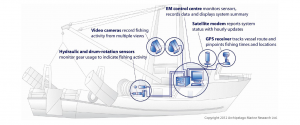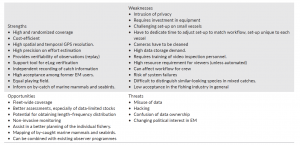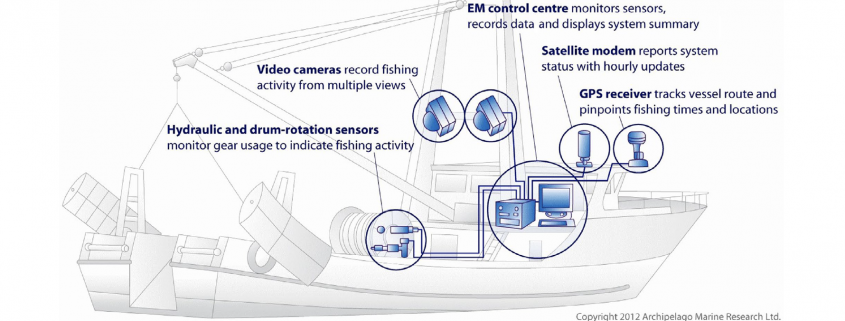Electronic monitoring in fisheries: Lessons from global experiences and future opportunities
By: Isabelle Geller, SRC intern
Marine life and the resources the oceans provide are not infinitely abundant. To protect the seas’ limited resources, protection and monitoring are of the utmost importance.
Prior to the 20th century, the impacts of large-scale fishing operations on the marine ecosystem were unknown and under-monitored. Today there is that technology that exists, such as Electronic Monitoring systems, which enable fisheries an easy way to adequately monitor their catch.
Electronic monitoring systems, or EM for short, consist of various sensors positioned on the vessel to remotely record fishing activity and catches – these include geographic positioning systems (GPS) and cameras, paired with computer hardware (Figure 1). The recordings taken are able to be replayed later to generate important catch information including species composition, numbers, volumes, and lengths (van Helmond et. al 2020). One of the advantages of the EM system is that it could eliminate the need for high cost “catch observing” personnel aboard fishing vessels.

Figure 1: Typical electronic monitoring system setup (van Helmond 2020).
A recent study found EM systems to have numerous advantages and disadvantages (Figure 2).
Three important disadvantages of the EM system include
- Possible data loss and the risk of system failure.
- Camera placement may be intrusive or blocked by dirt or vessel personnel.
- Low acceptance from the fishing industry because the system may represent governments’ mistrust of the fishers.

Figure 2: Analysis of the EM data collection compared with previous data collection methods (van Helmond 2020).
Despite the threats and disadvantages detailed above, according to the study the following three advantages greatly outweigh the disadvantages.
- In the long term the EM program is much more cost efficient than the current on-board observer program.
- Since recordings can be re-watched later to verify data, the EM system enables fisheries to document better fleet representations.
- Location and catch registration are made easier by the onboard GPS and ability to verify accurate bycatch.
The study found that EM on its can be used to fully document a fishery or in combination with current data collection techniques for management and compliance and or scientific data collection. The biggest challenge that proponents of EM systems face moving forward is the ability to rebrand their purpose as one of verifying fishers’ manual documentation of catch (for accurate data collection and fisheries management), rather than one of government intrusion based on mistrust.
Works cited
van Helmond, ATM, Mortensen, LO, Plet‐Hansen, KS, et al. Electronic monitoring in fisheries: Lessons from global experiences and future opportunities. Fish Fish. 2020; 21: 162– 189. https://doi.org/10.1111/faf.12425



